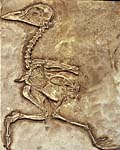Green River Formation : Vertebrates
Perhaps the best known vertebrate fossils are the spectacular fish. Gars, rays, herring, and an array of bony fish in all sizes have been found preserved in Green River strata.
Green River Formation : Vertebrates |
|
|
Some of the most important fossils from the Green River Formation are the
vertebrates. Among these are the oldest known bat, bird fossils assigned
to extinct families, snakes, turtles, and crocodylians.
Perhaps the best known vertebrate fossils are the spectacular fish. Gars, rays, herring, and an array of bony fish in all sizes have been found preserved in Green River strata. |
Chiroptera (bats) |
|
 |
Icaronycteris index - a bat
The oldest known fossil bat, the specimen is beautifully preserved. Not only is the complete skeleton intact, but there are indication of the wing membranes. |
Aves (birds) |
|
 |
Gruiformes - a gruiform.
This is a cast from the original specimen. Even so, you can see the fine detail with which the entire skeleton is preserved. In addition to recognizable groups, two entirely extinct families of birds were discovered from Green River. |
Testudines (turtles) |
|
 |
Baptemys garmanni - a turtle shell.
This is the anterior (front) portion of a rather sizable turtle. Unlike the skeletons above, most turtle shells have become broken during preservation, and must be reassembled like a jigsaw puzzle. |
Actinopterygii : Semionotiformes (gars and semionotids) |
|
 |
Lepisosteus sp. - a gar.
In some Green River localities, gars such as Lepisosteus make up half of the fossils found. Gars are important predators, and may grow to large size -- this one may may been more than two meters long. |
Actinopterygii : Teleostei (teleosts) |
|
 |
Diplomystus dentatus
Fossils of Diplomystus are among the most common found at Green River. |
 |
Knightia alta - a herring.
Fossils of Knightia are the most abundant and well-known of all the Green River fossils. It is rare to find a site where this fish is not present. |
 |
Mioplosus labracoides
|
 |
Priscacara pealei
|